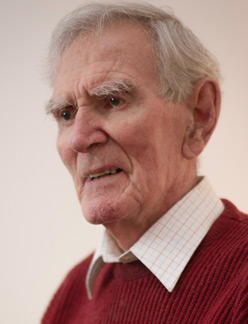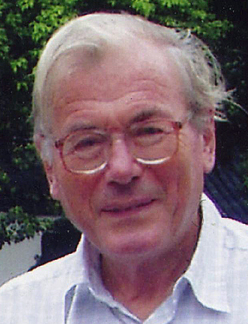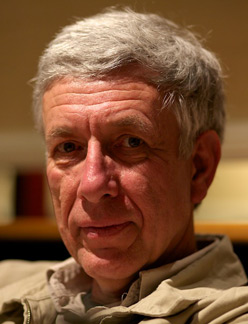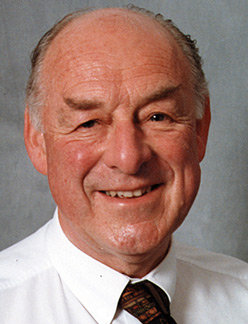
Dr Lloyd Evans AO FAA FRS was born 6 August, 1927 in Wanganui, New Zealand. Evans’s father was a wool operations manager; his mother passed away when he was only 10. Evans won a scholarship to the Wanganui Collegiate School and, troubled by the issue of world hunger, determined to pursue an agricultural career. Stricken with hepatitis just weeks before final exams, Evans still managed to win a bursary that allowed him to enrol at Lincoln College.
It was at university that Evans became keen on mountaineering, tramping all over New Zealand and noting local botany along the way. He completed a double degree in agricultural and pure science in 1948 and 1949, respectively, before pursuing a Master's degree in ecology.
In 1950, Evans won a Rhodes Scholarship to Oxford. As Oxford did not formally recognise degrees from Australia and New Zealand at the time, he was still regarded as a junior pupil and subject to a nightly curfew—his mountaineering experience came in handy when scaling spiked walls to sneak back into campus housing after hours. It was also at Oxford that Evans met his future wife, Margaret.
Evans's doctorate was awarded in 1954 for a thesis on soil science, but he maintained his interest in botany during his studies; Robert Orr Whyte's research on plant hormones and the shoot apex of grasses particularly captured his imagination. At a guest lecture at Oxford, Evans met botanist Frits Went, builder of the world's first research greenhouse (a phytotron), and following graduation in 1954, Evans received a Harkness Fellowship. He and his new wife moved almost immediately to America, where he joined Went at Caltech (the California Institute of Technology).
Evans was enamoured of Caltech's informal, energetic atmosphere, as well as the cutting-edge plant physiology research being undertaken. It was there that he began research on Lolium temulentum, an ordinary grass weed which would provide the focus for the rest of his career. A good model for wheat and barley, Lolium offered ground-breaking understanding of the way the crops responded to day length, influencing crop yield potential.
In 1956, Evans was recruited by Otto Frankel, head of CSIRO Division of Plant Industry, to build a phytotron in Australia. Evans moved to Canberra and teamed up with Roger Morse, head of the CSIRO Engineering Section, to construct the facility. Unveiled by Prime Minister Menzies in 1962, the phytotron featured in the first global TV link-up five years later.
In 1971, Evans reluctantly agreed to take the post of CSIRO Division of Plant Industry Chief, on the condition that it would be for a seven-year term, after which he could return to full-time research. That same year, Evans was elected to the Australian Academy of Science, where he was later elected President in 1978. During his tenure, Evans spearheaded the Academy's acquisition of Ian Potter House (then Beauchamp House) and oversaw the celebrations for the Academy's 25th Jubilee in 1979. Evans also served as President of the Australian and New Zealand Association for the Advancement of Science (ANZAAS), where at the annual Congress he addressed the public disaffection with science.
Evans was influential on the international scene, taking a number of sabbaticals from CSIRO to conduct research overseas, and working with the Consultative Group on International Agricultural Research (CGIAR) to improve crop production through physiology and breeding. He was a research powerhouse, authoring three books, editing numerous others, and co-writing several hundred papers. Evans continued lecturing worldwide following retirement in 1992.
These efforts were not without recognition: in addition to membership of numerous societies, Evans was the recipient of the Australian Medal of Agricultural Science (1978), the Farrer Memorial Medal and Oration (1979), the Centenary Medal (2003) and the Adolph Gude Jr. Award of the American Society of Plant Biologists (2004).
Dr Lloyd Evans passed away on 24 March 2015. He was predeceased by his wife Margaret and is survived by children Nicholas, John and Catherine.

Professor Michael Powell FAA FRS was born 29 July 1936 in London. As a young child he was frequently well ahead in his maths classes, which he credited to an excellent governess in mathematics and a deep enjoyment of books on the subject; in a 2005 interview with Professor Philip Davis, Powell fondly reminisced about learning trigonometry when trapped at home with the chicken pox.
Powell enrolled at Cambridge as an undergraduate, studying mathematics and numerical analysis and computing. After three years of studies, he took a position at the Atomic Energy Research Establishment at Harwell, where he worked for nearly seventeen years writing Autocode and FORTRAN programs. There he developed the Harwell Subroutine Library of numerical algorithms, and co-invented the Davidon-Fletcher-Powell method for numerical approximations.
In 1976, Powell returned to Cambridge as a professor, concurrently earning a Doctor of Science degree (1979). A founding member of the Institute of Mathematics and its Applications, Powell was an inexhaustible researcher, developing quasi-Newton methods and derivative-free optimisation algorithms. He authored numerous scientific papers and several books, as well as acting as a founding Managing Editor of the Journal for Numerical Analysis. A self-described loner, he preferred to work in less popular mathematical fields and to crack problems alone, estimating that he collaborated on less than half his papers.
Powell continued his research after retirement in 2001, working on optimisation and approximation. He received numerous awards for his work, including the George B. Dantzig Prize (1982) and the Naylor Prize (1983), and was elected as a Fellow of the Royal Society in 1983, a Foreign Member of the United States National Academy of Sciences in 2001, and a Corresponding Member of the Australian Academy of Science in 2007. Powell had close associations with researchers in Australia and was instrumental in providing postdoctoral opportunities for Australian graduate students.
Powell passed away on 19 April 2015.

Professor Michael Raupach FAA FTSE was born 30 October 1950. One of Australia’s foremost climate researchers, Raupach is credited with developing the concept of a carbon budget, a model describing the balance between CO2 emissions and absorption.
Raupach received his undergraduate degree in mathematical physics from the University of Adelaide in 1971 before pursuing a PhD at Flinders University. Postdoctoral studies took him to the University of Edinburgh, but Raupach returned to Australia in 1979 to join CSIRO as a Research Scientist. He spent over three decades there, where he was a Fellow and led the Marine and Atmospheric Research division of the Continental Biogeochemical Cycles Research Team. In 2014, Raupach was appointed director of the ANU Climate Change Institute.
In 2001, Raupach helped establish the Global Carbon Project (GCP), an internationally collaborative effort to understand and address the issues of climate change. An esteemed scientist, he was a member of the Australian Academy of Technological Sciences and Engineering and the American Geophysical Union, and was elected as an Academy Fellow in 2009. He was a valued contributor to the Academy, chairing the steering committee of the ‘Australia 2050’ project and co-chairing the working group of the recent update to the widely-read booklet ‘The science of climate change: Questions and answers’.
Raupach was deeply frustrated and sorrowful over the treatment of climate change as a political football, and the lack of progress in public understanding and willingness to change. When asked to sum up his feelings on the topic, Raupach wrote:
My feelings about climate change are a mixture of awe, hope, despair, frustration and anger.
Awe: Climate change is part of climate and climate is part of the natural world that sustains us. It is majestic and beautiful.
Hope: Humans are incredibly smart. We have the capabilities to repair climate and to lighten our footprints to what the planet can sustain.
Despair: Humans are incredibly dumb. We find it very hard to think beyond me, here and now. Yet our task is to fix a generation of problems that are global and centennial—to learn to share a finite planet.
Frustration: The situation has been clear for two decades, and we’re no further forward now than then.
Anger: Climate change has become everybody’s lightening rod, a route for conducting vast charges. Contrarians want to use it to beat up the left; the left want to use it to beat up capitalism; despair junkies want to use it to beat up everybody. Truth doesn’t stand a chance.
Raupach’s death sent shockwaves throughout the scientific community, with heartfelt tributes pouring in from around the globe that included a Senate speech in his honour by Senator Christine Milne. He is widely remembered as a brilliant and inspirational scientist, a passionate and courageous defender of our planet, and a mentor and friend to many.
Professor Michael Raupach passed away peacefully at home with his family on 10 February 2015. He is survived by wife Hilary and children Tim, Anna and Alex.

Professor Ian Mackay Ritchie AO FAA FTSE was born 18 March 1936 in Tidworth, England. He earned a B.A. in Natural Sciences and Chemical Engineering from Cambridge in 1958, and following graduation travelled to the United States to take up a position as an R&D engineer in Massachusetts.
In 1962 Ritchie relocated to Australia, teaching and studying at the University of Melbourne. He received a PhD in Physical Chemistry in 1966 and continued in his post as lecturer for six years before moving across the country to take up an associate professorship at the University of Western Australia. It was there that Ritchie’s interest in hydrometallurgy was sparked, and he found a good friend and willing collaborator in chemist Alan James (Jim) Parker. Ritchie moved to Murdoch University following Parker’s death; a decade later the A. J. Parker Cooperative Research Centre for Hydrometallurgy was established under Ritchie’s leadership. The centre developed into an international leader in its field, the largest hydrometallurgical research organisation in the world until its closure in 2012.
Ritchie retired from the Parker Centre in 2001, and stepped down from his position as Chair of Chemistry at Murdoch University the following year. His influence was deeply felt within both academia and the public sector: he spent two decades working with the WA Clean Air Committee, led a strategic review of ChemCentre, and was commemorated at Curtin University with a Chemistry Precinct wing named in his honour.
Ritchie’s many accolades include the Australasian Corrosion Medal (1979), the Stokes Medal for Electrochemistry (1997) and the Applied Research Medal of the RACI (1997). He was named West Australian Citizen of the Year in 1997 and received a Doctor of Science from Cambridge University in 1999, followed by Honorary Doctorate from Murdoch University in 2002. Ritchie was elected as an Academy Fellow in 2001, and was a member of the Royal Australian Chemical Institute and the Australian Academy of Technological Science and Engineering. In 2014, he was made an Officer of the Order of Australia.
Professor Ian Mackay Ritchie passed away on 2 August 2014. He is survived by his wife Ann, their children Katherine, Andrew and Alex, and five grandchildren.
© 2026 Australian Academy of Science